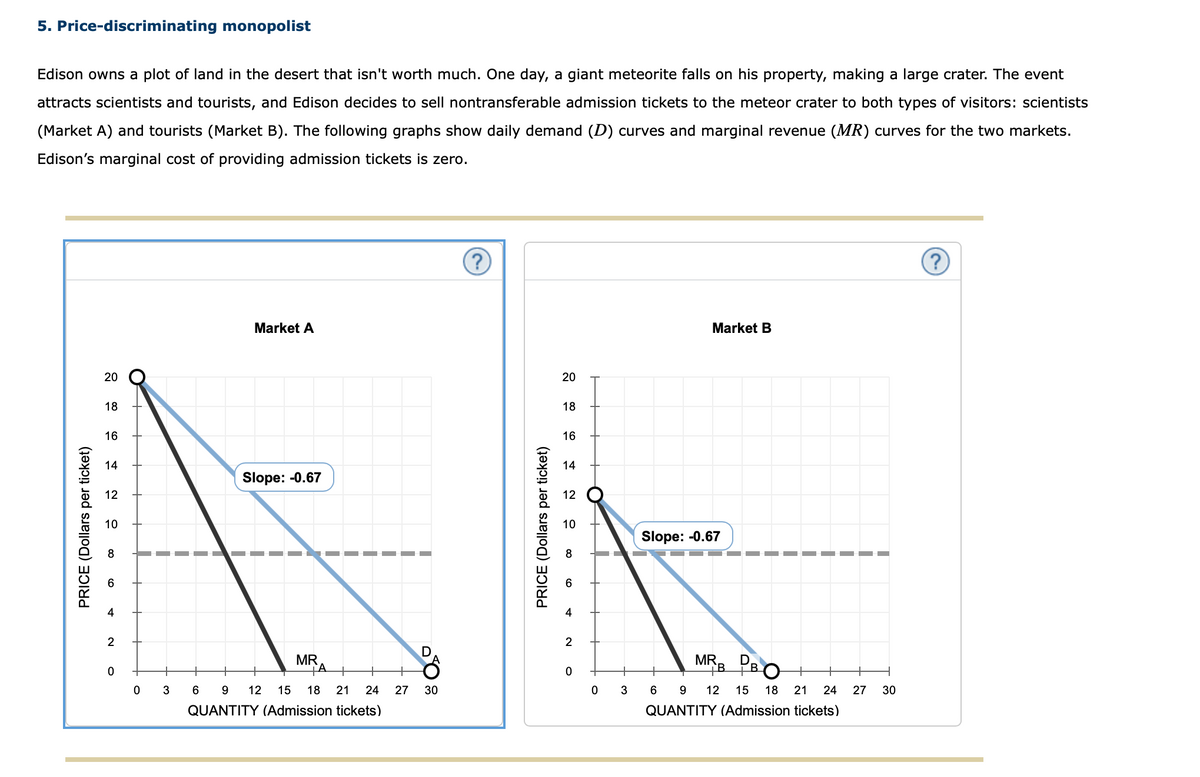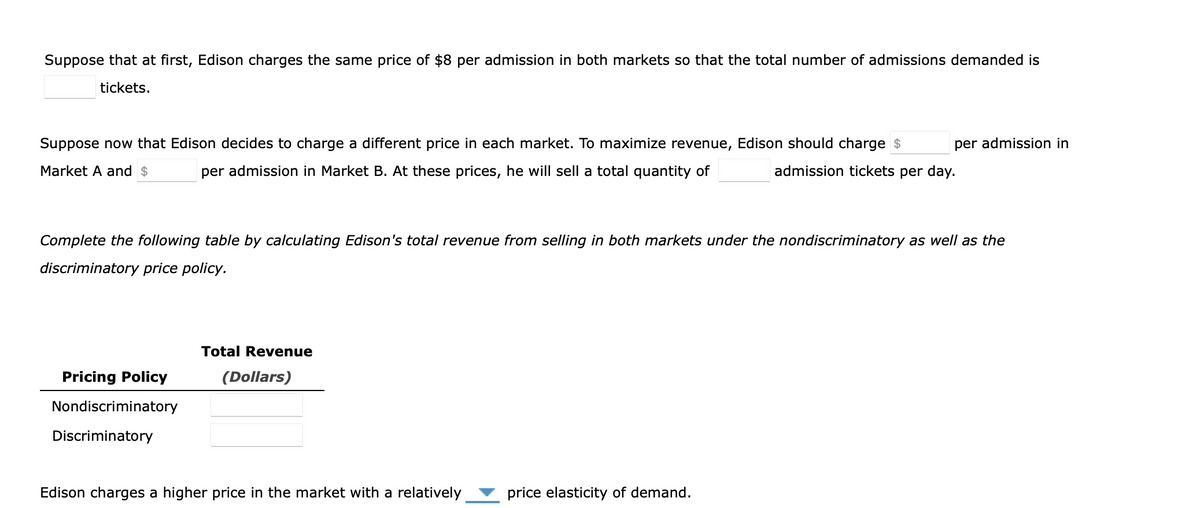Suppose that at first, Edison charges the same price of $8 per admission in both markets so that the total number of admissions demanded is tickets. Suppose now that Edison decides to charge a different price in each market. To maximize revenue, Edison should charge $ per admission in Market A and $ per admission in Market B. At these prices, he will sell a total quantity of admission tickets per day. Complete the following table by calculating Edison's total revenue from selling in both markets under the nondiscriminatory as well as the discriminatory price policy. Total Revenue Pricing Policy (Dollars) Nondiscriminatory Discriminatory Edison charges a higher price in the market with a relatively v price elasticity of demand.
Suppose that at first, Edison charges the same price of $8 per admission in both markets so that the total number of admissions demanded is tickets. Suppose now that Edison decides to charge a different price in each market. To maximize revenue, Edison should charge $ per admission in Market A and $ per admission in Market B. At these prices, he will sell a total quantity of admission tickets per day. Complete the following table by calculating Edison's total revenue from selling in both markets under the nondiscriminatory as well as the discriminatory price policy. Total Revenue Pricing Policy (Dollars) Nondiscriminatory Discriminatory Edison charges a higher price in the market with a relatively v price elasticity of demand.
Principles of Microeconomics
7th Edition
ISBN:9781305156050
Author:N. Gregory Mankiw
Publisher:N. Gregory Mankiw
Chapter16: Monopolistic Competition
Section: Chapter Questions
Problem 4PA
Related questions
Question

Transcribed Image Text:5. Price-discriminating monopolist
Edison owns a plot of land in the desert that isn't worth much. One day, a giant meteorite falls on his property, making a large crater. The event
attracts scientists and tourists, and Edison decides to sell nontransferable admission tickets to the meteor crater to both types of visitors: scientists
(Market A) and tourists (Market B). The following graphs show daily demand (D) curves and marginal revenue (MR) curves for the two markets.
Edison's marginal cost of providing admission tickets is zero.
(?
Market A
Market B
20
20
18
18
16
16
14
14
Slope: -0.67
12
12
10
10
Slope: -0.67
8
8
4
4
2
2
MR,
MRB PB(
+
3
9
12
15
18
21
24
27
30
3
12
15
18
21
24
27
30
QUANTITY (Admission tickets)
QUANTITY (Admission tickets)
PRICE (Dollars per ticket)
PRICE (Dolla
per ticket)

Transcribed Image Text:Suppose that at first, Edison charges the same price of $8 per admission in both markets so that the total number of admissions demanded is
tickets.
Suppose now that Edison decides to charge a different price in each market. To maximize revenue, Edison should charge $
per admission in
Market A and $
per admission in Market B. At these prices, he will sell a total quantity of
admission tickets per day.
Complete the following table by calculating Edison's total revenue from selling in both markets under the nondiscriminatory as well as the
discriminatory price policy.
Total Revenue
Pricing Policy
(Dollars)
Nondiscriminatory
Discriminatory
Edison charges a higher price in the market with a relatively
price elasticity of demand.
Expert Solution
This question has been solved!
Explore an expertly crafted, step-by-step solution for a thorough understanding of key concepts.
This is a popular solution!
Trending now
This is a popular solution!
Step by step
Solved in 3 steps with 1 images

Knowledge Booster
Learn more about
Need a deep-dive on the concept behind this application? Look no further. Learn more about this topic, economics and related others by exploring similar questions and additional content below.Recommended textbooks for you

Principles of Microeconomics
Economics
ISBN:
9781305156050
Author:
N. Gregory Mankiw
Publisher:
Cengage Learning

Principles of Economics, 7th Edition (MindTap Cou…
Economics
ISBN:
9781285165875
Author:
N. Gregory Mankiw
Publisher:
Cengage Learning

Principles of Economics (MindTap Course List)
Economics
ISBN:
9781305585126
Author:
N. Gregory Mankiw
Publisher:
Cengage Learning

Principles of Microeconomics
Economics
ISBN:
9781305156050
Author:
N. Gregory Mankiw
Publisher:
Cengage Learning

Principles of Economics, 7th Edition (MindTap Cou…
Economics
ISBN:
9781285165875
Author:
N. Gregory Mankiw
Publisher:
Cengage Learning

Principles of Economics (MindTap Course List)
Economics
ISBN:
9781305585126
Author:
N. Gregory Mankiw
Publisher:
Cengage Learning

Principles of Microeconomics (MindTap Course List)
Economics
ISBN:
9781305971493
Author:
N. Gregory Mankiw
Publisher:
Cengage Learning


Economics: Private and Public Choice (MindTap Cou…
Economics
ISBN:
9781305506725
Author:
James D. Gwartney, Richard L. Stroup, Russell S. Sobel, David A. Macpherson
Publisher:
Cengage Learning